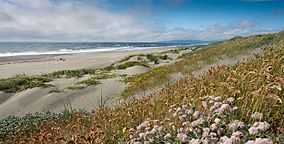Humboldt Bay National Wildlife Refuge facts for kids
Quick facts for kids Humboldt Bay National Wildlife Refuge |
|
|---|---|
|
IUCN Category IV (Habitat/Species Management Area)
|
|
 |
|
| Location | Humboldt County, California, United States |
| Nearest city | Eureka, California |
| Area | 4,000 acres (16 km2) |
| Established | 1971 |
| Governing body | U.S. Fish and Wildlife Service |
| Website | Humboldt Bay National Wildlife Refuge |
The Humboldt Bay National Wildlife Refuge is a special place in California. It is located on Humboldt Bay, along the North Coast. This refuge is close to the cities of Eureka and Arcata.
This refuge was created to protect and improve wetland areas. These wetlands are super important for many birds. Tens of thousands of shorebirds, ducks, geese, and swans visit here. This includes the special black brant.
Humboldt Bay National Wildlife Refuge is a key stop for millions of birds. These birds travel along the Pacific Flyway. This is like a superhighway in the sky for birds! Over 200 different kinds of birds use this area. About 80 of these are water birds. Four of them are even endangered species. These birds come to the refuge to eat, rest, or build their nests.
Contents
What Animals Live Here?
Fish and Marine Life
Humboldt Bay is home to about 100 different kinds of fish. Many of these fish are important for fishing. You can find fish like steelhead, coho, and Chinook salmon here.
Birds and Their Journeys
The bay has large beds of eelgrass. In the spring, these eelgrass beds are a vital spot for brant gooses. They stop here before flying all the way to their nesting grounds in the Arctic.
The refuge also has grasslands. These grasslands are important for thousands of Aleutian cackling geese. These geese roost, or rest, on the island from late January to early April.
Marine Mammals
Castle Rock National Wildlife Refuge is part of this area too. It's a resting spot for marine mammals. You might see harbor seals, northern elephant seals, California sea lions, and Steller sea lions here.
About the Refuge Complex
Humboldt National Wildlife Refuge Complex
The Humboldt Bay National Wildlife Refuge is the biggest part of something called the Humboldt National Wildlife Refuge Complex. This "Complex" is like a group of special areas. Its main office is south of Eureka, in Loleta, California.
The Complex also manages two other important places:
- The Lanphere Dunes Unit
- The Castle Rock National Wildlife Refuge
Lanphere Dunes Unit
The Lanphere Dunes are on the northern coast of Humboldt Bay. This area has one of the most natural dune ecosystems in the Pacific Northwest. It has old forests on dunes, new active dunes, wet areas between dunes, and coastal salt marsh.
Castle Rock National Wildlife Refuge
Castle Rock National Wildlife Refuge is a small island. It is about 14-acre (57,000 m2) in size. The island is about 80 miles (130 km) north of Humboldt Bay. It's less than 1-mile (1.6 km) off the coast near Crescent City.
This island is the second-largest place where seabirds nest in California. It has the biggest group of common murres breeding in California.
![]() This article incorporates public domain material from websites or documents of the United States Fish and Wildlife Service.
This article incorporates public domain material from websites or documents of the United States Fish and Wildlife Service.


